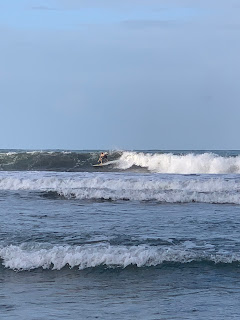Beach Break Versus Reef Break- differences between surfing a beach break and a reef break.
The Difference Between a beach break, and a reef break. Surfing Costa Rica, and Mexico.
Beach break Versus reef Break
In the past year I have spent two months surfing a fun reef break in Punta de Mita Mexico. Now eight months later we are living in Cahuita Costa Rica. surfing an epic beach break, every morning and afternoon. Here are the differences I have noticed transitioning from surfing a reef break to a beach break.
What is a Reef Break,
A reef break occurs when ocean waves break when they pass over a section of coral reef, or rocky seabed. I enjoy surfing reef breaks because they are often easier to paddle out because you can go around the waves. It is also easier to figure out where you should position yourself to catch waves.
What is a beach break,
A beach break occurs over a sandy seabed. As waves approach the shore, the gradual slope of the sandy bottom causes the waves to break. Beach breaks are common along coastlines. I enjoy surfing beach breaks because the waves are often steeper making for a more thrilling drop in. The waves are usually shorter and more powerful, making for an exciting ride.
Main differences between a reef break, and a beach break.
Seabed Composition:
Beach Break: Waves break over a sandy seabed with a gradual slope towards the shore.
Reef Break: Waves break over a coral reef or rocky seabed, which can create unique wave formations.
Ride length:
Reef Break: Generally, reef breaks tend to offer longer rides compared to beach breaks. The presence of a reef or rocky seabed often shapes and slows down the incoming waves, allowing them to break more gradually and consistently. This can create longer, more sustained rides for surfers.
Beach Breaks: beach breaks may have shorter rides as the waves break more abruptly over the sandy bottom. This can create steaper waves.
Hazards:
Beach Break:
Rip Currents, Strong currents flowing away from the shore can form in deeper channels between sandbars, posing a hazard to surfers by pulling them away from the coastline
Wave Closeouts, Beach breaks may experience waves that break simultaneously along the entire beach, creating what surfers call “closeouts.” These waves can cause you to go over the falls. (Going over the falls is when a surfer gets caught in the lip or crest of a breaking wave and is carried over the top of it)
Reef break
Coral and Rocks: Collisions with the reef or underwater rocks can cause injuries to surfers. The sharp edges of coral can lead to cuts and abrasions.
Shallow Water: Reef breaks often occur in shallower waters over the reef, increasing the risk of hitting the seabed during wipeouts.
Conclusion
My Conclusion is that I love surfing both reef breaks, and beach breaks. As long as there Is a wave I’m going to be out surfing it.



Comments
Post a Comment